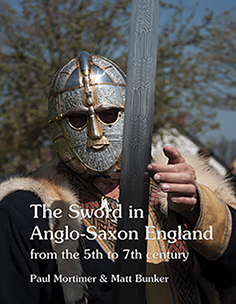Interview with Matt Bunker
I stumbled across Matt while researching Anglo Saxon swords and I was looking for a book on the subject. I found Anglo Saxon Books, and there I found Matt and Paul Mortimer’s Book, The Sword in Anglo-Saxon England – a massively weighty tome on all things sword in the Anglo Saxon world. It is a monster book and well worth the read…
Tell us a little about yourself.
A child of the late 60s, born in Lincolnshire but grew up all over the place. Now living in North Somerset with Anna, my partner of 23 years but my work in the defence industry has taken me all over the world. One daughter and two grandchildren.
What made you focus on the period of history you have written about?
I was born in the ancient Danelaw wapentake of Bradley Haverstoc, in the North Riding of Lindsey and lived there until it was abolished in 1974. As a child, I had a pre Conquest church in sight of my bedroom window.
My mother’s surname is Aldred and I grew up listening to the tales of Grim and Havelock, told to me by the older male members of her family, who were trawlermen who still had customs, traditions and superstitions that smacked of pagan ritual.
I’ve been interested in Anglo Saxon history and culture as long as I can remember. I don’t remember a time when I wasn’t interested in the period or the culture.
Where do you do most of your writing?
In summer, in my garden under the wisteria. Usually with a gin to hand.
Otherwise, at the kitchen table, surrounded by heaps of books.
Share one strange fact you found while researching your work?
Not strange so much and possibly not even surprising but the number of errors to be found in the basic data contained in some archaeological reports was a bit of a shock. In particular example, a trip to look at the finds archive revealed some details of scabbard construction that were previously unknown in Britain and which were missing entirely from the report.
What is your favourite resource for carrying out research?
Handling the physical objects themselves. There’s an awful lot of detail that you miss if you rely on drawings, photos, descriptions etc. Failing that, I’ve become very adept at taking macro photos of objects in museums and then using those to explore details that aren’t always visible to the naked eye.
What are you working on next?
Couple of things. I’m currently working with some colleagues to investigate some previously unexplored details of early medieval shields and I’m also trying to finish the analysis of an unpublished 6th century weapons burial from Wiltshire.
And there might be another sword book, somewhere down the road.
Where can people find about more about your work? Are you active on social media, publish your own website for example?
I post a lot on Facebook, both on my own page and also on the page of Wulfheodenas, a group that I belong to which attempts to create aspects of the mead-hall culture of the 6th-7th century. I’ve got a few papers that I’ve previously presented which could go on Academia, but I never seem to find the time to get around to posting them.
Books
The Sword in Anglo-Saxon England
Paul Mortimer and Matt Bunker
The contributors to this book bring their practical and academic knowledge to an exploration of new ideas and information about the making and use of swords in the early Anglo-Saxon period. They provide an insight to the symbolism of swords, their decoration and place in society. Other items carried and worn by warriors are similarly treated.
There is an extensive survey of writings about swords from the Early Middle Ages, together with discussions on the way swords may have been used and worn. There is a chapter about the language of the sword and runic associations. Several modern sword-smiths have contributed knowledge gained from forging weapons. In addition to those who have contributed essays, there are many scholars, smiths, craftspeople, re-enactors and others who have added to the ideas, theories and discussions presented in this book.
< BACK